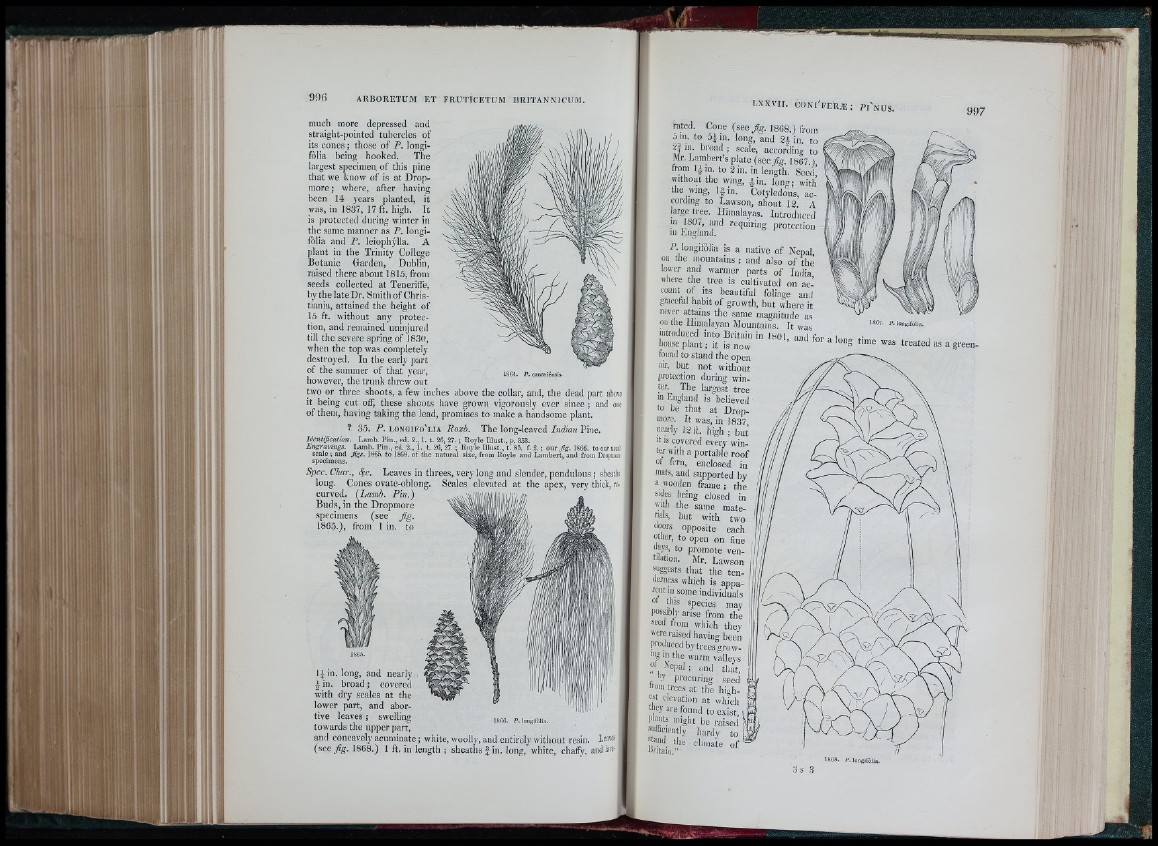
9 9 ( ) A R BO R E TUM E T F R U T IC E T UM B R IT A N N IC UM .
much more depressed and
straight-pointed tubercles of
its cones ; those of P. longifòlia
being hooked. The
largest specimea of this pine
that we know of is at Drop-
more ; where, after having
been 14 years planted, it
was, in 1837, 17 ft. high. It
is protected during winter in
the same manner as P. longifòlia
and P . leiophylla. A
plant in the Trinity College
Botanic Garden, Dublin,
raised there about 1815, from
seeds collected at Teneriffe,
by the late Dr. Smith of Christiania,
attained the height of
15 ft. without any protection,
and remained uninjured
till the severe spring of 1830,
when the top was completely
destroyed. In the early part
of the summer of that year,
however, the trunk threw out
two or three shoots, a few inches above the collar, and, the dead part above
it being cut off] these shoots have grown vigorously ever since ; and one
of them, having taking the lead, promises to make a handsome plant.
? 35. P. l o n g i f o ' l t a B o x ò . The long-leaved Indian Pine.
Identification. Lamb. Pin., ed. 2., 1. t. 26, 27. ; Royle Illust., p. 353.
Engravings. Lamb. Pin., ed. 2., 1. t. 26, 27. ; Royle Illust., t. 85. f. 2. ; o u r / g . 1866. toourusual
scale ; and Jigs. 1865. to 1868. of the natura l size, from Royle and Lambert, and from Dropmore
specimems.
Spec. Char., Leaves in threes, very long and slender, pendulous ; sbeatlis
long. Cones ovate-oblong. Scales elevated at the apex, very thick, recurved,
(Lamb. Pin.)
Buds, in the Dropmore
specimens (see Jig.
1865.), from 1 in. to
1864. P. canariénsis.
IJin. long, and nearly
A in. broad ; covered
with dry scales at the
lower part, and abortive
leaves ; swelling
towards the upper part,
and concavely acuminate; white, woolly, and entirely without resin
{see Jig. 1868.) 1 ft. in length ; sheaths f in . long, white, chaffy,
L .x x v i i . c o n i ' f e r / e : p i ' NUS.
ftited. Cotie (seey%. 1 8 6 8 .) from
5 in. to ÓJ in. long, and 2* in. to
in. broad ; scale, according to
Mr. Lamliert’s plate (see fig. 1867 I
from IJin. to 2 in. in length. Seed!
without the wing, Jin . long; with
the wing, if in . Cotyledons, according
to Lawson, about 12. A
large tree, Himalayas. Introduced
in 1807, and requiring protection
in England.
/». longifòlia is a native of Nepal
on the niountains ; and also of thó
lower and warmer parts of India,
wliere the tree is cultivated on ac-
rouiit o its beautiful foli.age and
gmccful habit of growth, but where it
never attains the same magnitude as
oil the Himalayan Mountains. It was
in fm r l i i / o o r l T>
997
A.xwuiiLaiua. 1C w a s P. loii”Kifòlia.
introduced into Britain in 1801 and for 4.'
Iiouse plant; it is now ’ ° treated as
found to stand the open
air, but not without
protection during winter.
The largest tree
m England «"believed
to be that at Drop-
more. It was, in 1837
"airly 1 2 ft. high; but’
It IS covered every winter
with a portable roof
of fern, enclosed in
mats, and supported by
a wooden frame ; the
sides being closed in
with the same materials,
but with two
doors opposite each
other, to open on fine
days, to promote ventilation.
Mr. Lawson
siigge.sts that the ten-
derness which is apparent
III some individuals
or this species may
possibly arise from the
seed from wliich they
were raised having been
produced by trees growing
in the warm valleys
" '/ o p a l ; and that,
iiy procuring seed
iroin trees at the highest
elevation at which
tliey are found to exist,
pkmts imglit lie raised
sufficiently hardy to
and the climate of
Dntiuti.”
a green